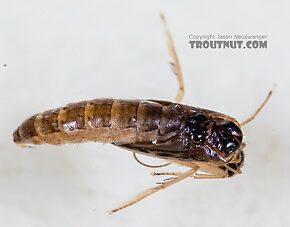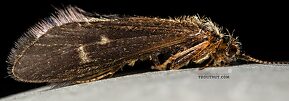Blog & Latest Updates
Fly Fishing Articles
Insects by Common Name


Caddisfly Species Helicopsyche borealis (Speckled Peter)
Taxonomic Navigation -?-
Kingdom
Animalia (Animals)
» Phylum
Arthropoda (Arthropods)
» Class
Insecta (Insects)
» Order
Trichoptera (Caddisflies)
» Family
Helicopsychidae
» Genus
Helicopsyche (Speckled Peters)
» Species borealis (Speckled Peter)
Common Name
| Match | Common Name |
| Speckled Peter |
The adult appears different in flight from other caddisflies because the top set of wings is attached to the bottom by a row of hooks, so the four wings beat together, not as two spread-out sets.
Where & When
Regions: East, Midwest, West
Time Of Year (?): Early May through July
Preferred Waters: Rivers or lakes; best in spring creeks and large rivers
The emergence of this species lasts a few weeks in any given location. It begins in the East in early May and lasts through June, while in the West it begins in mid-June and lasts through early July.Time Of Year (?): Early May through July
Preferred Waters: Rivers or lakes; best in spring creeks and large rivers
Hatching Behavior
Time Of Day (?): Evening
Egg-Laying Behavior
Time Of Day: Evening
LaFontaine gives a slightly confusing account of the ovipositing behaivor of this species in Caddisflies, suggesting that they may flutter around on or near the water's surface looking for solid objects to attach their eggs to, or may drop them in the water. Swisher and Richards give a clearer picture in Selective Trout:During egg laying, the females float in the surface close to the banks, crawl underwater, and flop on the surface to oviposit. They then ride the water serenely in the normal resting position, and trout take them with gentle rises.
Larva & Pupa Biology
Diet: Algae, detritus (Detritus: Small, loose pieces of decaying organic matter underwater.), animal matter
Environmental Tolerance: Very tolerant: can thrive in both cold water and hot springs up to 110°F
Shelter Type: Coiled sand case shaped like a snail shell
Pictures of 2 Caddisfly Specimens in the Species Helicopsyche borealis:
Helicopsyche borealis (Speckled Peter) Caddisfly Pupa View 13 PicturesI'm calling this one very tentatively Helicopsyche borealis, with some big caveats that I might be wrong.
View 13 PicturesI'm calling this one very tentatively Helicopsyche borealis, with some big caveats that I might be wrong.
It seems to key fairly easily to Helicopsychidae, except at the last couplet in Merritt & Cummins (5th ed) it's supposed to have âanal processes short and straight, each with several mesal (Mesal: Toward the middle.) setae (Seta: Little hairs on insects.) and 2 long apical (Apical: Close to the apex; tip or end.) setae (Seta: Little hairs on insects.),â whereas this one has VERY short, straight processes with 3 long apical (Apical: Close to the apex; tip or end.) setae (Seta: Little hairs on insects.) and no mesal (Mesal: Toward the middle.) ones.
Additionally, the only species of Helicopsychidae documented in this region is Helicopsyche borealis, which is supposed to emerge much later in the summer.
 View 13 PicturesI'm calling this one very tentatively Helicopsyche borealis, with some big caveats that I might be wrong.
View 13 PicturesI'm calling this one very tentatively Helicopsyche borealis, with some big caveats that I might be wrong.It seems to key fairly easily to Helicopsychidae, except at the last couplet in Merritt & Cummins (5th ed) it's supposed to have âanal processes short and straight, each with several mesal (Mesal: Toward the middle.) setae (Seta: Little hairs on insects.) and 2 long apical (Apical: Close to the apex; tip or end.) setae (Seta: Little hairs on insects.),â whereas this one has VERY short, straight processes with 3 long apical (Apical: Close to the apex; tip or end.) setae (Seta: Little hairs on insects.) and no mesal (Mesal: Toward the middle.) ones.
Additionally, the only species of Helicopsychidae documented in this region is Helicopsyche borealis, which is supposed to emerge much later in the summer.
Collected April 9, 2021 from the Yakima River in Washington
Added to Troutnut.com by Troutnut on April 12, 2021
Added to Troutnut.com by Troutnut on April 12, 2021
Helicopsyche borealis (Speckled Peter) Caddisfly Adult View 7 PicturesThis one keys pretty easily to the Helicopsychidae family, of which there is only one genus in North America, and one species reported in this general area.
View 7 PicturesThis one keys pretty easily to the Helicopsychidae family, of which there is only one genus in North America, and one species reported in this general area.
 View 7 PicturesThis one keys pretty easily to the Helicopsychidae family, of which there is only one genus in North America, and one species reported in this general area.
View 7 PicturesThis one keys pretty easily to the Helicopsychidae family, of which there is only one genus in North America, and one species reported in this general area.Collected July 31, 2020 from the Henry's Fork of the Snake River in Idaho
Added to Troutnut.com by Troutnut on August 17, 2020
Added to Troutnut.com by Troutnut on August 17, 2020
Your Thoughts On Helicopsyche borealis:
Top 10 Fly Hatches
Top Gift Shop Designs
Eat mayflies.
Top Insect Specimens
Miscellaneous Sites
Troutnut.com is copyright © 2004-2024 Jason
Neuswanger (email Jason). See my FAQ for information about use of my images.
 privacy policy
privacy policy
